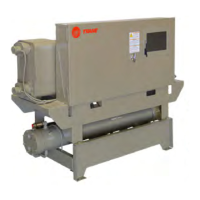Unit Piping
CG-SVX038A-EN 25
Refrigerant Piping (CCAR only)
Note: If using a Trane CAUJ air-cooled condenser with a
Trane CCAR compressor chiller, please refer to the
Application Guide - Pairing Trane CCAR
Compressor Chillers with Trane CAUJ Air-Cooled
Condensers SS-APG014*-EN. This guide provides
line sizing, field-component selection, application
considerations and more. If not using a Trane CAUJ
air-cooled condenser, please consider the
following general guidelines and
recommendations when designing your split
system.
Refer to the industry standards for refrigerant piping
selection information; contact the factory if you do not
have access to this data. Refrigerant pipe size selected
must be within the velocity and pressure drop limitations
required for proper system operation. It is essential that
refrigerant piping be properly sized and applied since
these factors have a significant effect on performance.
Note: Use Type K refrigerant-grade copper tubing only.
The use of a lower grade tubing can cause
operating problems.
General Guidelines
Keep these general guidelines in mind as you review the
recommendations specific to field piping refrigerant lines:
• Limit overall line length. Enough sub-cooling may be
lost as refrigerant travels up the liquid riser to cause
flashing. Review any questionable applications with
the factory.
• Pipe sizing software suc
h as Trane Engineering
Toolbox can help to quickly determine proper sizes for
refrigerant lines based on current engineering data.
Liquid Line
Sufficient sub-cooling must be maintained at the
expansion valve. To provide proper operation throughout
the range of operating conditions, the liquid-line pressure
drop should not exceed the unit’s minimum sub-cooling
value less 5°F. To achieve this objective, keep these liquid-
line considerations in mind:
1. Select the smallest, practical line size for the
application. Limiting the refrigerant charge improves
compressor reliability.
2. When designing the liquid l
ine for a typical air-
conditioning application (i.e., one with an operating
range of 40°F to 110°F), remember that every 10 feet of
ver
tical rise will reduce sub-cooling by 2.8°F, while
every 10 feet of vertical drop will add 1.1°F of sub-
cooling.
3. Provide a 1-inch pitch toward the e
vaporator for every
10 feet of run.
4. If the liquid line must be routed through an area
w
armer than outdoor air temperature, insulate the line
to prevent the refrigerant from flashing.
5. A replaceable core liquid line filter drier must be
in
stalled as close as possible to the compressor chiller.
The core should be changed whenever the system is
opened for service. Trane compressor chillers do not
include a filter-drier as standard, but one may be
ordered if the installing contractor desires a factory
type.
6. A moisture-indicating sight glass permits
a visual
check of the liquid column for bubbles. Sight glasses
are included on the Trane compressor-chiller. However,
never use the sight glass to determine whether the
system is properly charged! Instead, either charge the
system based on the required sub-cooling or calculate
the amount of refrigerant needed and add it based on
weight.
Discharge (Hot Gas) Line
Limit the pressure drop in the discharge line to 6 psid
whenever possible to minimize the adverse effect on unit
capacity and efficiency. While a pressure drop of as much
as 10 psid is usually permissible, note that a 6-psid
pressure drop reduces unit capacity by 0.9 percent and
efficiency by 3 percent.
Pitch discharge lines in the direction of hot gas flow at the
rate of 1/2-inch per each 10 feet of horizontal run.
Discharge line sizing is based on required velocity to
provide good oil movement. Basic discharge line
parameters are:
Max allowable pressure drop 6 psig (1F)
Maximum Velocity 3500 fpm
Minimum Velocity (at minimum load)
Horizontal lines 500 fpm
Vertical lines (up flow) 1000 fpm
To design the discharge line properly, follow the
recommended guidelines:
• Choose the shortest route from the compre
ssor to the
condenser.
• Use different pipe sizes for horizontal and vertical lines
to
make it easier to match line pressure drop and
refrigerant velocity to discharge-line requirements.
• To assure proper oil entrainm
ent and avoid annoying
sound levels, size the discharge line so refrigerant
velocity equals or exceeds the minimum velocity in
Tabl e 10 and remains below 3,500 fpm.
• Prevent oil and condensed refrigerant from flowing
bac
k into the compressor during “off” cycles by:
a. pitching the discharge line tow
ard the condenser,
and
b. routing the discharge line so that it rises to the top
of the condenser, then drops to the level of the
condenser inlet, creating an inverted trap.

